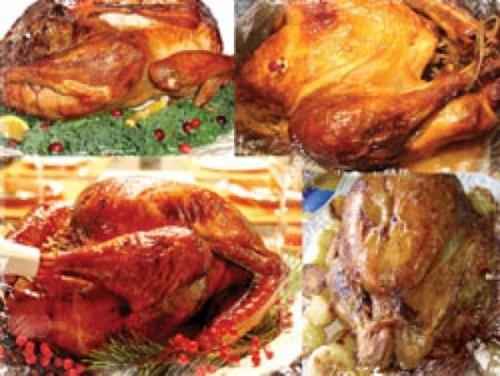Flipping the Bird: Dispelling turkey myths as you prepare for your Thanksgiving feast.
By Ted Scheffler @critic1Thanksgiving is next Thursday, and I’ve got turkey on the brain. You too? Excellent. Let’s talk.
In an attempt this season to liven up my otherwise too-predictable Thanksgiving dinner, I’ve immersed myself in all things turkey. But after sorting through dozens of impressive turkey recipes, I came to realize I’m not certain anymore what a turkey is. When we put that big, glistening, perfectly browned bird on our Thanksgiving table once a year, do we even know what we’re eating? Here’s the most unexpected bit of turkey knowledge I came across this week: Wild turkeys spend the night in trees. Yup, they perch on tall tree branches. I didn’t even know the bastards could fly.
But that’s not all. I’d always been taught that turkeys were uniquely American. You know—the pilgrims and all that. Well, yes and no. Turkeys were hunted by American Indians—long before America became America—as far back as 1000 A.D., and used turkey feathers both as fashion accoutrements and to stabilize arrows. (Adult turkeys have 3,500 feathers!)
For those of you who believe the Earth to be older than 2,000 years, there’s evidence of turkeys in the fossil record in the New World dating back 10 million years. The first humans to domesticate the wild turkey were the Aztecs of ancient Mexico. Aztec honcho Montezuma was given 365,000 turkeys annually by his subjects as a supreme gift of tribute. I’ll bet if they looked closely, food historians and culinary anthropologists would find a lot of turkey chili and turkey tetrazzini in the Aztec diet. Could all that tryptophan have inspired the siesta?
Probably not. Conventional wisdom is that the reason we Americans crash on the couch following the Thanksgiving meal is because turkeys are loaded with the amino acid tryptophan, which can make you drowsy. Well, that’s bunk. Only pure tryptophan taken on an empty stomach in copious amounts will have a sedative effect. The amount of tryptophan in turkey is way too low for that, weighing in at about the same ratio as soybeans, peanuts, fish, brown rice, beef, barley and dairy products. So you’ll need to get your serotonin fix elsewhere. The more likely cause of Thanksgiving Day sloth is overeating, excess drinking and the simple fact that you have the day off and your body is probably just catching up with some much-needed rest. But if you still want to employ the tryptophan defense, it’ll be our secret.
The commercially raised turkey you’ll likely eat this Thanksgiving cannot fly. Or couldn’t when it was alive. In part, that’s because they’re not svelte like their wild cousins. In wild turkey world, gobblers (males) tip the scale at about 16 lbs. and hens (females) about half that. A commercial turkey can reach 30 pounds; the heftiest turkey on record, according to Guinness, weighed in at 86 pounds. Typical genetically engineered big-breast turkeys tend to tip over while standing thanks to their unnatural size. This year, some 275 million turkeys will be produced in the United States commercially, mostly in North Carolina, Minnesota, Arkansas, Virginia, Missouri and California. Think turkey is all-American? Israelis eat more turkey per person on average than anyone else: 28 pounds per person versus around 17 pounds for Americans.
The pilgrims didn’t brine their turkeys. I do. Each year, I get loads of requests for my favorite roasted-turkey recipe, which City Weekly published a few years back. Go online to SLWeekly.com, and search for “Ted Talks Turkey.”
If I were to fixate on the two most important keys to producing a successful roasted turkey for a holiday meal, I’d select the importance of brining your turkey and of starting out with a respectable bird in the first place. If you happen to know a local turkey farmer who can provide you with a fresh tom, great. If not, at least go to the trouble to seek out an all-natural, organic turkey, one that hasn’t been raised on antibiotics and pumped full of fillers to make it plump and juicy. Remember, if you’re buying a Butterball or other commercially popular turkey, you’re probably paying for injections of water, stock, butter, oil, sodium and other seasonings as well as turkey. But you can easily find wholesome, natural turkeys at places like Dan’s, Wild Oats and boutique grocers such as Liberty Heights Fresh and Emigration Market. You’ll probably have to order your bird in advance. On the Internet, try quality outfits such as LocalHarvest.org.
Ever wondered where the heads from all those holiday turkeys wind up? Well, I found a Website that sells freeze-dried turkey heads. Their sales pitch: “You don’t have to use those artificial plastic turkey heads. Now you can have freeze-dried heads and save money, too!” Plus, they offer variety. You can get your freeze-dried turkey heads in any of the following postures: alert, strutting, flying or (my favorite) gobbling.
Each year the American president ritually pardons a turkey and sets the bird free. This year, Dick Cheney will bite a live turkey’s head off, thereby initiating a new executive branch tradition that will cause Hillary to end her presidential run. Happy Thanksgiving.
More by Ted Scheffler
-
Flavor on the Western Front
Nomad Eatery ups the ante for off-airport eats.
- Dec 13, 2017
-
Under the Christmas Tree
Holiday gifts for cooks, foodies and winos
- Dec 6, 2017
-
Spreading the Love
Amour Café creates simple yet scrumptious fare.
- Nov 29, 2017
- More »





